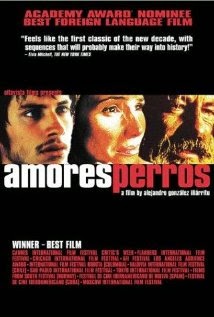Amores Perros
Aside from Alfonso Cuaron and Guillermo Del Toro, the most prominent Mexican director these days is Alejandro González Iñárritu. Like the other two, he is now a Hollywood director, but his film debut made quite a splash in 2000.
Amores Perros (Life's a Bitch) is, like this subsequent films, 21 Grams and Babel, a triptych film, with multiple stories linked by a single incident. In this case it is a traffic accident in Mexico City. The only other uniting factor in these stories are the presence of dogs.
The first story concerns Gael Garcia Bernal as a young man who is in love with his brother's wife. They begin an affair, and he tries to make money so they can get away. He discovers that his dog is a great fighter, and enters him underground dogfighting competitions, earning a great deal of money. After he has vanquished the dogs of several of a local gangster's, the angered man puts a bullet in Bernal's dog. Bernal stabs the man, and he and his buddy must flee. The chase ends with a horrible crash.
The second story concerns the other victim of the crash, a fashion model (Goya Toledo). She has just moved in with her lover, who has left his wife. They have a new apartment, overlooking a giant billboard of her in her new campaign. They also have a small pampered dog.
After the accident, she is in a wheelchair, and while playing catch the dog gets lost under some loose floorboards, where he remains for weeks. The ensuing tension, plus Toledo's declining health, make the relationship suffer intensely.
The third story concerns a bystander of the crash. El Chivo, (Emilio Ecchevaria) who was a revolutionary, now lives as a vagrant, his hair and beard long and matted. He has a menagerie of stray dogs that he tends to, but in reality he is a hired assassin. He gets an assignment to kill a young man, but the accident distracts him. He learns more about the man and finds that his own brother has hired him to kill him.
Amores Perros was an international sensation when it was released, earning an Oscar nomination for Best Foreign Language Film. It still holds up pretty well, but I wonder if it hasn't lost some its luster due to other films using the same technique, including Iñárritu himself. Still, the film has undeniable power, such as when Ecchevaria leaves a gun between the two brothers, our imaginations allowing us to play that out, or the scene in which the killer leaves a message for his daughter, who presumes him dead.
As mentioned, dogs play a critical role in the film, and there are many scenes of dog violence, which are unsettling. I would assume that none came to any harm in the making of the film, but it's still jarring.
Amores Perros (Life's a Bitch) is, like this subsequent films, 21 Grams and Babel, a triptych film, with multiple stories linked by a single incident. In this case it is a traffic accident in Mexico City. The only other uniting factor in these stories are the presence of dogs.
The first story concerns Gael Garcia Bernal as a young man who is in love with his brother's wife. They begin an affair, and he tries to make money so they can get away. He discovers that his dog is a great fighter, and enters him underground dogfighting competitions, earning a great deal of money. After he has vanquished the dogs of several of a local gangster's, the angered man puts a bullet in Bernal's dog. Bernal stabs the man, and he and his buddy must flee. The chase ends with a horrible crash.
The second story concerns the other victim of the crash, a fashion model (Goya Toledo). She has just moved in with her lover, who has left his wife. They have a new apartment, overlooking a giant billboard of her in her new campaign. They also have a small pampered dog.
After the accident, she is in a wheelchair, and while playing catch the dog gets lost under some loose floorboards, where he remains for weeks. The ensuing tension, plus Toledo's declining health, make the relationship suffer intensely.
The third story concerns a bystander of the crash. El Chivo, (Emilio Ecchevaria) who was a revolutionary, now lives as a vagrant, his hair and beard long and matted. He has a menagerie of stray dogs that he tends to, but in reality he is a hired assassin. He gets an assignment to kill a young man, but the accident distracts him. He learns more about the man and finds that his own brother has hired him to kill him.
Amores Perros was an international sensation when it was released, earning an Oscar nomination for Best Foreign Language Film. It still holds up pretty well, but I wonder if it hasn't lost some its luster due to other films using the same technique, including Iñárritu himself. Still, the film has undeniable power, such as when Ecchevaria leaves a gun between the two brothers, our imaginations allowing us to play that out, or the scene in which the killer leaves a message for his daughter, who presumes him dead.
As mentioned, dogs play a critical role in the film, and there are many scenes of dog violence, which are unsettling. I would assume that none came to any harm in the making of the film, but it's still jarring.



Comments
Post a Comment